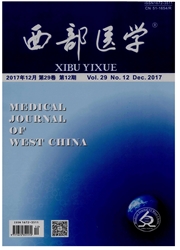

 中文摘要:
中文摘要:
目的建立Balb/C小鼠的急性哮喘模型,应用复方黄龙汤进行治疗,并与地塞米松治疗效果比较,探讨复方黄龙汤对小鼠哮喘气道炎症的影响及作用机制。方法选取24只6~8周龄雌性Balb/C小鼠,体重(20±2)g,应用随机数字法随机分为正常对照组(A组)、哮喘模型组(B组)、地塞米松治疗组(C组)和复方黄龙汤治疗组(D组),每组6只。应用卵白蛋白致敏液腹腔注射联合OVA雾化吸入法建立哮喘模型,B、C、D组在第0、14天向小鼠腹腔注射0VA配置而成的致敏液0.2ml,第28、29、30天吸入1%OVA/PBS 10m1激发哮喘,造模23天后,C组每天给予地塞来松(2mg/kg),D组每天给予复方黄龙汤(2.7ml/kg);激发结束后,用无创肺功能测量仪测量小鼠气道反应性,qRT-PCR法测定小鼠肺组织中T-bet及GATA-3mRNA的含量,酶联吸附反应测定肺泡灌洗液中IL-4及IFN-γ含量,将肺泡灌洗液离心沉淀后涂片进行中性粒细胞、嗜酸性粒细胞和淋巴细胞等炎性细胞计数,用HE染色肺组织,评价病理改变。结果无创肺功能显示雾化吸入乙酰胆碱剂量〉12.5μg/ml时,C组和D组penh值明显低于B组(P〈0.05),但高于A组,差异无统计学意义;肺组织中T-betmRNA表达B组高于A组(P〈0.001),D组含量高于B组,但差异无统计学意义(P〉0.05)。而GATA-3mRNA表达C、D组低于B组(均P〈0.01)。肺泡灌洗液中IL-4含量B组高于A、C和D组(均P〈0.01),而IFN-γ含量B组远低于A组(均P〈0.01),D组肺泡灌洗液中IFN-γ含量较B组升高,差异有统计学意义(PGO.05);在小鼠肺泡灌洗液中B组嗜酸粒细胞(EOS)比C、D组明显增多(P〈0.01);B组气道壁和肺组织中大量炎性细胞浸润(以嗜酸性粒细胞、淋巴细胞为主),支气管管壁增厚,管腔狭窄,与A组比较差异明显;C、D两组小鼠细支气管管腔呈圆形,?
 英文摘要:
英文摘要:
Objective To investigate the effect and mechanism of Fu-Fang- Huang- Long Decoction on acute airway inflammation of asthmatic mice. Methods Health female Balb/C mice were randomly divided into four groups: control group (group A), asthma group (group B), dexamethasone group (group C) and Fu-Fang-Huang- Long Decoction group (group D). Asthma rat model was induced by ovalbumin (OVA, via intraperitoneal injection) combined with OVA aerosol administration. After modeling, dexamethasone (2mg/kg) and Fu Fang Huang Long decoction (2.7ml/kg) was administra- ted in group C and D, respectively. The airway reactivity (AR) was determined with pulmonary function test apparatus. The expression of T-bet/GATA-3mRNA was determined using q-RT-PCR. The level of IL-4 and IFN-7 in alveolar ]avage fluid was evaluated using enzyme linked immunosorbent assay (ELISA). Hematoxylin and Eosin (HE) staining was per- formed to evaluate the pulmonary pathologies. Results None -invasive lung ruction reveals that when chloride acetycholine dose is higher than 12.5μg/ml, the penh value in groups C and D is significantly lower than group B(P〈0. 05), but higher than group A. There is no significant difference between group C and D. Significant decrease of T-bet mRNA expression was noted in group B compared with group A(P〈0. 001). Though T-bet mRNA expression in group D is higher than group C, there is no significant difference between them(P〉0.05). For the expression of GATA-3 mR.NA, remarkable increase was noted in group B compared with group C and D. Higher expression of IL-4 was noted in group B compared with the other groups (P〈0.01). For the level of IFN-7, remarkable decrease was noted in group B compared with group A. Significant increase was noted in BALF, eosinophitic granulocytes (EOS) in group B compared with those obtained from group C and D, respectively (P~0.01). A large number of inflammatory cells were in the airway wall and lung tissue of Group B (eo- sino
 同期刊论文项目
同期刊论文项目
 同项目期刊论文
同项目期刊论文
 期刊信息
期刊信息
